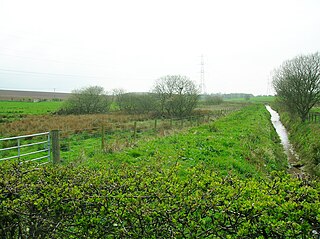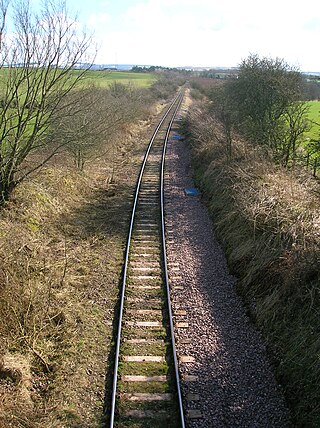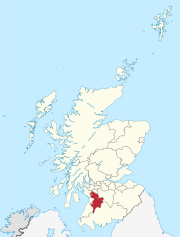
Auchenmade railway station was a railway station approximately three miles (4.8 km) north-east of Kilwinning on the B707, North Ayrshire, Scotland. It served the hamlet of Auchentiber and the surrounding rural area as part of the Lanarkshire and Ayrshire Railway. The station was 6.75 miles (10.86 km) from the Lugton East Junction.

The Glasgow, Paisley, Kilmarnock and Ayr Railway (GPK&AR) was a railway in Scotland that provided train services between Glasgow, Kilmarnock and Ayr. It opened its first line, between Glasgow and Ayr, in stages from 1839 to 1840. The section between Glasgow and Paisley was made jointly with the Glasgow, Paisley and Greenock Railway. Later it built a line from Dalry via Kilmarnock to Cumnock, linking there with the Glasgow, Dumfries and Carlisle Railway, and together forming a through route from Glasgow to Carlisle. The two companies merged to form the Glasgow and South Western Railway.

Trabboch is a hamlet in East Ayrshire, Scotland. Built as a miners village in the 1880s, it was owned and leased by Wm. Baird & Co., Ltd. and at one time had 94 dwellings. The miners rows stood, until demolition in 1969, on the Stair and Littlemill road, about two miles south of Stair, in that parish. The name is locally pronounced 'Traaboch'.

Trabboch railway station (NS434218) was a railway station serving the village of Trabboch, East Ayrshire, Scotland. The station was originally part of the Ayr and Cumnock Branch on the Glasgow and South Western Railway.

Cronberry is a small hamlet situated north-east of Cumnock and one mile north-east of Lugar, in East Ayrshire, Scotland.
Muirkirk railway station was a railway station serving the village of Muirkirk, East Ayrshire, Scotland.
The Glasgow and South Western Railway operated a number of cross-country lines in Ayrshire.

Wallace's Heel Well or Wallace's Heel is located beside the River Ayr (NS35502122) near the old Holmston lime kiln, Ayr, Scotland. It is a petrosomatoglyph said to represent the imprint of a heel and is associated with the story of an escape from English soldiers made by the Scottish hero William Wallace.

The Auchincruive Waggonway or Whitletts Waggonway was a mineral railway or 'Bogey line' that transported mainly coal, eventually running from the north side of Ayr harbour at Newton to Blackhouse, Whitletts, Dalmilling, Gibbsyard, Auchincruive Holm, Annbank and Enterkine. Apart from carrying coal to the harbour, lime kilns, quarries and a salt works were also served.

The Craigie Waggonway was a short lived mineral railway or 'Bogey line' of just over a mile in length that transported coal from five or more coal pits on the Craigie Estate to Ayr where it was either used locally or was taken to the harbour in carts for export, mainly to Ireland.

Killochan railway station was located in a rural part of South Ayrshire, Scotland and mainly served the nearby Killochan Castle estate. The Killochan bank is the name given to this section of the line, running from Girvan on an uphill gradient to just north of the old station site. Maybole is around nine miles away and Girvan two miles.

The Grangeston Halt railway station was a private station that was not listed in the public timetables, located in a rural part of South Ayrshire, Scotland and served the WWII Grangeston ICI munitions plant bringing workers to the site. Grant's Distillery now occupies much of the site.

Girvan Old railway station was a terminus station opened in Girvan, in Carrick, South Ayrshire, Scotland by the Maybole and Girvan Railway. Although ambitions existed to extend the line through to Stranraer it was built on a site that would not permit this and so when the line was built the Girvan New station was opened on 5 October 1877 by the Girvan and Portpatrick Junction Railway on the route to Pinmore and eventually through to Stranraer railway station.

Garrochburn Goods Depot or Garrochburn Siding was a railway freight facility located off the B744 near the hamlet of Crosshands that lies north-west of Mauchline, East Ayrshire, Scotland. It served the industrial and agricultural requirements for transportation in the vicinity of Crosshands and the surrounding rural area, originally on behalf of the Glasgow and South-Western Railway. Garrochburn Goods Depot was 40.4 miles (65.0 km) from Glasgow, 6.82 miles (10.98 km) from Kilmarnock and 2.72 miles (4.38 km) from Mauchline. The old clachan of Ladeside once stood nearby and the mill at Dalsangan remains as a private house having lost its water supply upon the draining of Loch Brown when the railway was built, that is apart from that of the Garroch or Ladeside Burn that cuts under the railway to the south of the old siding.

Mossgiel Tunnel Platform railway station (NS480292) was not a station constructed for public use. It stood close to the northern portal of the 680 yard Mossgiel Tunnel that runs under the Mossgiel Ridge and Skeoch Hill north of Mauchline, East Ayrshire, Scotland. It may have solely served the transportation requirements of the Glasgow and South-Western Railway and its successor in connection with the carriage of workers involved in the ongoing maintenance and/or the major reconstruction of Mossgiel Tunnel that took place between 1925 and 1927. It was not recorded in the 1896 G&SWR working time table and had closed sometime after July 1926.

Wallace's Cave in the Lugar Gorge at Auchinleck in the Parish of Auchinleck is an 18th-century grotto contemporary with Dr Johnson's Summerhouse, also located on the Auchinleck Estate. It shows superior workmanship in its construction, possibly being the enlargement of a pre-existing cave. The cave or grotto lies downstream of the confluence of the Dippol Burn with the River Lugar and is reached via a once well formed path, however access is now hazardous due to the condition of the cliff edge path and the vertical drop into the River Lugar.

Weston Bridge Platform railway station or Weston Bridge Halt railway station was opened to serve miners travelling to the Ayr Colliery No. 9 Pit that stood near Annbank and those from the village that worked at other pits in the area, East Ayrshire, Scotland. The station was on the line that was originally part of the Ayr and Cumnock Branch of the Glasgow and South Western Railway. The location was well chosen as it lay close to the village, the hamlet of Burnbrae and at the busy crossroads at Weston Bridge.

The Blacksyke Tower, Blacksyke Engine House, Caprington Colliery Engine House or even Lusk's Folly is a Scheduled Monument associated with a double lime kiln complex in the Parish of Riccarton and is a building of national importance. The Blacksyke site is a significant survival of early coal and lime industries. The engine house's mock Gothic tower house style is very unusual and rare survival of its type. This late-18th-century engine house would be one of the oldest surviving examples of its kind in the United Kingdom. The track bed of the wagonway and several sidings that linked the complex with the Kilmarnock and Troon Railway can still be clearly made out.

Murdoch's Cave, is a relatively small artificial cave created by William Murdoch (1754-1839) and his siblings in the soft red sandstone Lugar river bank cliff just upstream of the old Bellow Mill close to the confluence of the Bellow or Bello Water and the Glenmuir Water in Lugar, East Ayrshire, Scotland. The spelling 'Bellow' is used for consistency.



















